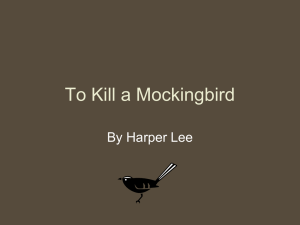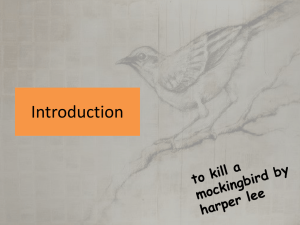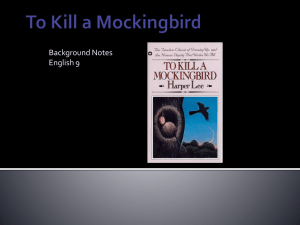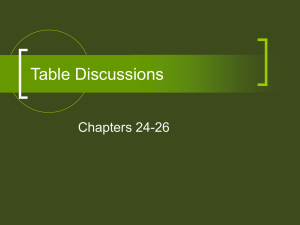realism, gothic elements, allusion etc
advertisement
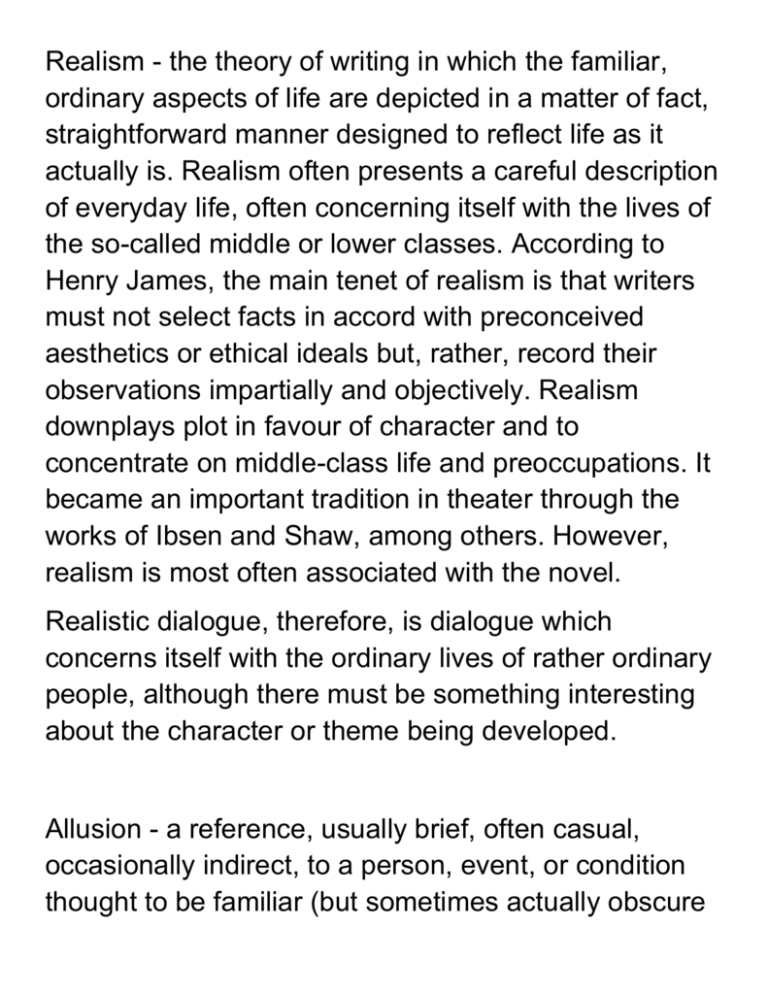
Realism - the theory of writing in which the familiar, ordinary aspects of life are depicted in a matter of fact, straightforward manner designed to reflect life as it actually is. Realism often presents a careful description of everyday life, often concerning itself with the lives of the so-called middle or lower classes. According to Henry James, the main tenet of realism is that writers must not select facts in accord with preconceived aesthetics or ethical ideals but, rather, record their observations impartially and objectively. Realism downplays plot in favour of character and to concentrate on middle-class life and preoccupations. It became an important tradition in theater through the works of Ibsen and Shaw, among others. However, realism is most often associated with the novel. Realistic dialogue, therefore, is dialogue which concerns itself with the ordinary lives of rather ordinary people, although there must be something interesting about the character or theme being developed. Allusion - a reference, usually brief, often casual, occasionally indirect, to a person, event, or condition thought to be familiar (but sometimes actually obscure or unknown) to the reader. This holds true especially for the characters and events of mythology, legends, and history. Association is an essential part of allusion. The purpose of allusion is to bring a world of experience outside the limitations of a statement to the reader. Western writers often use Biblical allusions also. Where is the Biblical allusion to the cup of the Garden of Gethsemane in To Kill a Mockingbird? Gothic Elements in To Kill a Mockingbird The novel contains characteristics of the Gothic novel. The most notable of them is the presence of a mysterious recluse, Boo Radley, living in a foreboding house: The house . . . was once white with a deep front porch and green shutters, but had along ago darkened to the color of the slate-gray yard around it. Rain-rotted shingles drooped over the eaves of the veranda; oak trees kept the sun away. The remains of a picket drunkenly guarded the front yard. . . . Inside the house lived a malevolent phantom. People said he existed, but Jem and I had never seen him. People said he went out at night when the moon was down, and peeped in windows. When people's azaleas froze in a cold snap, it was because he had breathed on them. Any stealthy small crimes committed in Maycomb were his work." .......Another characteristic is the suggestion that supernatural powers are at work. For example, when Jem mentions the term Hot Steam and Dill asks him to define it, Scout reports Jem's answer as follows: "Haven't you ever walked along a lonesome road at night and passed by a hot place?" Jem asked Dill. "A Hot Steam's somebody who can't get to heaven, just wallows around on lonesome roads an' if you walk through him, when you die you'll be one too, an' you'll go around at night suckin' people's breath-- . . . If you hafta go through one you say, 'Angel-bright, life-indeath; get off the road, don't suck my breath.' That keeps 'em from wrapping around you—" .......Other Gothic characteristics include a grotesque presence, such as the mad dog; a seemingly unnatural occurrence, such as the snowstorm; ventures into the unknown, such as the children's invasion of the Radley property on a dark night; and a frightening encounter, such as the one the children experience with Bob Ewell on Halloween night. Structure and Style ~ episodic nature Harper Lee wrote To Kill a Mockingbird in episodes resembling short stories after introducing her family and recounting some of its history. However, the central theme—focusing on the lessons a little girl learns about the real world as she grows up in her own idyllic world—unites these episodes into a single story. Smooth transitions link one episode to the next. Examples of episodes are Scout’s first day at school, the children’s invasion of the Radley property, the snowstorm, the fire, Christmas at Finch’s landing, the shooting of the rabid dog, the encounter with Mrs. Dubose, Sunday services at Calpurnia’s church, the gathering of the lynch mob, the trial and verdict, and Bob Ewell’s retaliation. Lee divides the story into two parts, the first centering on Scout’s adventures and the lessons she learns from them and the second centering on the lessons Scout learns from her exposure to racism and injustice during the rape trial and its aftermath. Lee writes in easy-to-understand prose characterized by vivid descriptions and wit, as in the following paragraph from Chapter 2 about her first day of school in the first grade: Miss Caroline began the day by reading us a story about cats. The cats had long conversations with one another, they wore cunning little clothes and lived in a warm house beneath a kitchen stove. By the time Mrs. Cat called the drugstore for an order of chocolate malted mice the class was wriggling like a bucketful of catawba worms. Miss Caroline seemed unaware that the ragged, denim-shirted and floursack-skirted first grade, most of whom had chopped cotton and fed hogs from the time they were able to walk, were immune to imaginative literature. After discovering that Scout is already quite literate— Scout gives a demonstration by reading the stockmarket quotations from The Mobile Register—Miss Caroline assumes her father taught her and asks her to tell him not to teach her anymore because it would interfere with her method: using flash cards that say "cat," "rat," and other one-syllable words. But Scout says her father "hasn't taught me anything," then apologizes for her advanced skill in a paragraph that further demonstrates the author's wit and vigorous style: I mumbled that I was sorry and retired meditating upon my crime. I never deliberately learned to read, but somehow I had been wallowing illicitly in the daily papers. . . . Now that I was compelled to think about it, reading was just something that came to me, as learning to fasten the seat of my union suit without looking around, or achieving two bows from a snarl of shoelaces. Lee also writes dialogue seasoned skillfully with the patois of southern whites and blacks, as in the following passage in which Calpurnia, the Finch family's black cook, scolds Scout for poking fun at the way her classmate Walter Cunningham drenches his food in molasses while eating lunch at the Finch house: "There's some folks who don't eat like us," she whispered fiercely, "but you ain't called on to contradict 'em at the table when they don't. That boy's yo' comp'ny and if he wants to eat up the tablecloth you let him, you hear?" "He ain't company, Cal, he's just a Cunningham—" "Hush your mouth! Don't matter who they are, anybody sets foot in this house's yo' comp'ny, and don't you let me catch you remarkin' on their ways like you was so high and mighty." Lee often uses such snippets of dialogue to underscore a lesson Scout learns about life—in this case, that people come in many varieties and have all kinds of likes and dislikes. Pouring molasses on a plateful of food isn't wrong, she learns; it is just different. JUXTAPOSITION: The arrangement of two or more ideas, characters, actions, settings, phrases, or words side-by-side or in similar narrative moments for the purpose of comparison, contrast, rhetorical effect, suspense, or character development. We will look at mirroring pairs and foil pairs in To Kill a Mockingbird


